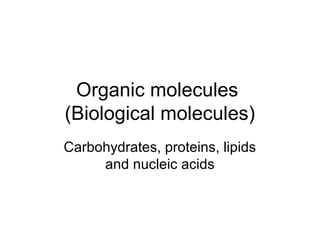Organic compounds
•Télécharger en tant que PPT, PDF•
4 j'aime•3,509 vues
Signaler
Partager
Signaler
Partager

Recommandé
Recommandé
Contenu connexe
Tendances
Tendances (20)
Biology - Chp 2 - The Chemistry Of Life - PowerPoint

Biology - Chp 2 - The Chemistry Of Life - PowerPoint
En vedette
En vedette (20)
Organic Chemistry: Classification of Organic Compounds

Organic Chemistry: Classification of Organic Compounds
Organic Chemistry: Classification of Organic Compounds: Seminar

Organic Chemistry: Classification of Organic Compounds: Seminar
Similaire à Organic compounds
Similaire à Organic compounds (20)
Carbon Chemistry and Applications - Gurumurthy B R

Carbon Chemistry and Applications - Gurumurthy B R
Bio unit 1 biological elements and biomolecules notes

Bio unit 1 biological elements and biomolecules notes
Plus de eziennker
Plus de eziennker (20)
Dernier
Mehran University Newsletter is a Quarterly Publication from Public Relations OfficeMehran University Newsletter Vol-X, Issue-I, 2024

Mehran University Newsletter Vol-X, Issue-I, 2024Mehran University of Engineering & Technology, Jamshoro
Dernier (20)
Salient Features of India constitution especially power and functions

Salient Features of India constitution especially power and functions
Beyond_Borders_Understanding_Anime_and_Manga_Fandom_A_Comprehensive_Audience_...

Beyond_Borders_Understanding_Anime_and_Manga_Fandom_A_Comprehensive_Audience_...
HMCS Vancouver Pre-Deployment Brief - May 2024 (Web Version).pptx

HMCS Vancouver Pre-Deployment Brief - May 2024 (Web Version).pptx
This PowerPoint helps students to consider the concept of infinity.

This PowerPoint helps students to consider the concept of infinity.
UGC NET Paper 1 Mathematical Reasoning & Aptitude.pdf

UGC NET Paper 1 Mathematical Reasoning & Aptitude.pdf
Python Notes for mca i year students osmania university.docx

Python Notes for mca i year students osmania university.docx
NO1 Top Black Magic Specialist In Lahore Black magic In Pakistan Kala Ilam Ex...

NO1 Top Black Magic Specialist In Lahore Black magic In Pakistan Kala Ilam Ex...
Fostering Friendships - Enhancing Social Bonds in the Classroom

Fostering Friendships - Enhancing Social Bonds in the Classroom
Basic Civil Engineering first year Notes- Chapter 4 Building.pptx

Basic Civil Engineering first year Notes- Chapter 4 Building.pptx
ICT role in 21st century education and it's challenges.

ICT role in 21st century education and it's challenges.
General Principles of Intellectual Property: Concepts of Intellectual Proper...

General Principles of Intellectual Property: Concepts of Intellectual Proper...
Organic compounds
- 1. Organic molecules (Biological molecules) Carbohydrates, proteins, lipids and nucleic acids
- 2. Living organisms on Earth are made of primarily water and molecules containing carbon
- 3. Vocab word Definition 1. Organic Molecules that contain carbon. molecules All life on Earth is organic – we all contain carbon Picture
- 4. What’s so special about Carbon? Carbon is a versatile atom – It has four electrons in an outer shell that holds eight – Carbon can share its electrons with other atoms to form up to four covalent bonds
- 5. What’s so special about Carbon? Carbon can use its bonds to – Attach to other carbons – Form an endless diversity of carbon skeletons
- 6. Four Basic Types of Organic Molecule 1. carbohydrates (sugars and starches) 2. lipids (fats) 3. Proteins (enzymes and antibodies) 4. nucleic acids (DNA and RNA). – Because they are large, these molecules are called macromolecules.
- 7. Carbohydrate: Contains: 2. Carbohydrates Carbon (sugars and Hydrogen starches – Oxygen “saccharides” ) Functions: •used for energy •Stores energy •Forms body structures Examples: breads, pastas, starches, fruit
- 8. There are three types of carbohydrates! 1. Monosaccharides 2. Disaccharides 3. Polysaccharides
- 9. 3 types of Carbohydrates 3. Monosaccharides Simple sugars - glucose (soft drinks) - fructose (fruit) One strand of carbon and hydrogen
- 10. 3 types of Carbohydrates 4. Disaccharides Two monosaccharides linked together Di – means 2 Sucrose – table sugar Most common type of carbohydrate
- 11. 3 types of Carbohydrates 5. Polysaccharides (complex carbohydrates) Many saccharides linked together Very big Starches and cellulose (plant sugars) wood
- 12. Lipids! 6. Lipids - fats Contains: Carbon Hydrogen oxygen Functions: • Stores energy (more energy than carbohydrates) • Forms cell membranes • Carries messages (nerves) Examples: fats and oils
- 13. Common types of lipids: 7. Phospholipids the main component of cell membranes
- 14. Common types of lipids: 8. Steroids hydrocarbons with the carbon atoms arranged in a set of 4 linked rings. Examples: cholesterol, steroid hormones, waxes
- 15. Proteins: 9. Proteins Contains: Carbon Hydrogen Oxygen Nitrogen and sulfur Functions: •Helps cells keep their shape •Makes up muscles •speeds up chemical reactions •Carries messages and materials Examples: enzymes, antibodies, amino acids
- 16. Types of proteins: subunits of proteins, 10. Amino Acids There are 20 different kinds of amino acids in proteins.
- 17. Proteins: 11. Enzymes all metabolic transformations, building up, rearranging, and breaking down of organic compounds, are done by enzymes, which are proteins.
- 18. Nucleic Acids: 12. Nucleic Acids Contains: Carbon Hydrogen Oxygen Phosphorus and nitrogen Functions: •Contains instructions for proteins •Passes instructions from parent to offspring •Helps make proteins Examples: DNA RNA
- 19. Two types of nucleic Acids: 13. DNA Contains: four bases adenine, guanine, thymine, and cytosine. The order of these bases in a chain of DNA determines the genetic information. DNA consists of 2 complementary chains twisted into a double helix and held together by hydrogen bonds.
- 20. Two types of nucleic Acids: 14. RNA Contains: RNA consists of a single chain that also uses 4 bases: however, the thymine in DNA is replaced by uracil in RNA. RNA is much less stable than DNA, but it can act as an enzyme to promote chemical reactions in some situations.
- 21. Exit slip 1. List and give and example of the four types of organic molecules. 2. What is carbon and why is it important for life on Earth?